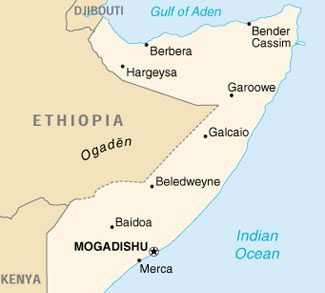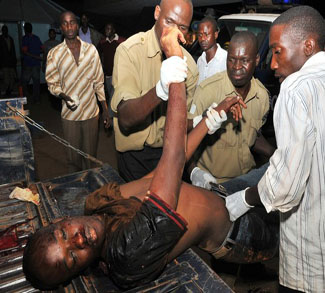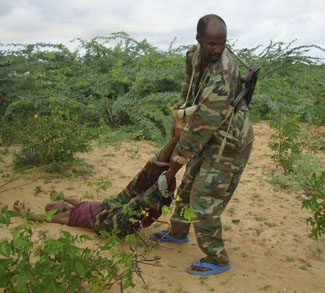Summary
A recent Amnesty International report documenting war crimes by US-backed forces in Somalia and US air strikes that have killed more Somali civilians than alleged al-Qaeda operatives underscore Washington’s role in Somalia’s humanitarian crisis. However, Washington has defended its role in Somalia as part of the “war on terror”, a rhetorical tact to establish a US military presence in the Horn of Africa and control the region’s potential oil reserves.
Analysis
London-based NGO Amnesty International issued a report this week documenting widespread atrocities against Somali civilians by US-backed Ethiopian occupation forces and Somali government troops.
Although both sides in Somalia’s civil war have committed atrocities, the report emphasizes the actions of US-backed forces, with Somali refugees describing Ethiopian and Transitional Federal Government (TFG) troops carrying out summary executions, torture, gang rapes, and the arbitrary detention of civilians in war-torn Mogadishu as well as neighbourhoods suspected of sympathies to the Islamist insurgency.
Ethiopia rebukes the report, which has been overlooked by US media in preference of coverage on Darfur, Tibet, and Zimbabwe.
This is not surprising, since the atrocities in Somalia are the direct consequence of a “regime change” operation launched in December 2006 by Washington who armed, trained, and financed tens of thousands of Ethiopian troops sent into Somalia as a proxy army.The goal was to overthrow the Islamic Courts Union (ICU), which Washington and Addis Ababa accused of having links to al-Qaeda, the 1998 bombings of US embassies in Kenya and Tanzania, and the 2002 attacks on Israeli tourists in Kenya.
Such accusations have been unsubstantiated and even the Pentagon has admitted that it cannot prove them, yet this has not deterred the operation nor the US military’s direct involvement, such as bombing fleeing refugees, slaughtering innocent herdsmen, and destroying entire villages in its efforts to kill a few alleged al-Qaeda operatives, as well as sending in death squads to kill any remaining survivors of US air strikes.
Unlike the ICU, whose brief government enjoyed popular support and restored civil order when it drove out looting warlords, the TFG, led by warlords on the CIA’s payroll, has failed to secure control of the country. Instead, Washington’s client regime has radicalized the opposition and exacerbated the extremism it claims to combat, as seen by the growth of al-Shabab, a militant wing of the ICU that spearheaded the insurgency and whom Washington designated a terror group this March.
Occurring against the backdrop of natural disasters and food insecurity, the fighting has killed thousands of Somali civilians and displaced millions. As a result, Somalia is facing its worst humanitarian crisis since 1993.
Meanwhile Washington undermined reconciliation efforts this past February by pressuring the moderate Prime Minister Nur Hassan Hussein to exclude certain opposition groups and individuals with suspected terror links from the negotiation process. And the deaths of dozens of civilians via a May 1 US air strike against al-Shabab leader and alleged head of al-Qaeda in Somalia, Aden Hashi Ayro, is likely to scuttle UN-sponsored peace talks in Djibouti on May 10.
Against growing criticism from foreign policy analysts, think tanks, and human rights groups, Washington has defended its intervention in Somalia as essential in the “war on terror”. But what is truly essential to Washington is the establishment of a client regime that will facilitate a US naval base along Somalia’s 1,800 mile coast overlooking strategic shipping lanes between the Red Sea and the Indian Ocean used for Middle Eastern oil shipments.
Also essential is control of Somalia’s potential oil reserves, which would see the Horn of Africa become an extension of oil production in the Middle East if oil exploration proves successful.
With such interests at stake, the US is likely to continue its policy of offensive warfare instead of deterrence and engagement, thus extending Somalia’s humanitarian crisis and turning it into the next Afghanistan.
History
Despite its significant geo-strategic importance, Somalia is one of the poorest countries in Africa and has been without a functioning government since 1991 when the US-backed dictator Mohammed Siad Barre was overthrown by opposing clan warlords and the country plunged into civil war.
In late 1992, under the guise of a humanitarian mission providing famine relief, the US sent in 30,000 troops to regain control of Somalia but was subsequently driven out of the country in 1993 in the infamous “Black-Hawk down” incident that killed 19 US troops.
The US turned its back on Somalia until after 9/11, when it believed that Somalia’s anarchy would provide the perfect breeding ground for terrorists driven from Afghanistan. Also of concern was the rise of the ICU, a loose coalition of Islamic groups seeking to drive out the clan warlords and restore order in Mogadishu through Sharia law.
In response, the CIA sent agents into Mogadishu to pay the very warlords who fought against the US in 1993 to fight the ICU, but when the ICU defeated the warlords and set up a government in June 2006, the US sought out Christian Ethiopia—a Western ally and historic enemy of Sunni Muslim Somalia—to launch an invasion that would “sweep out the Islamists”.
The Ethiopian invasion coincided with Washington’s goal of creating AFRICOM, which signals the militarization of US foreign policy in Africa.
Marsha Reid is a contributor to Geopoliticalmonitor.com



